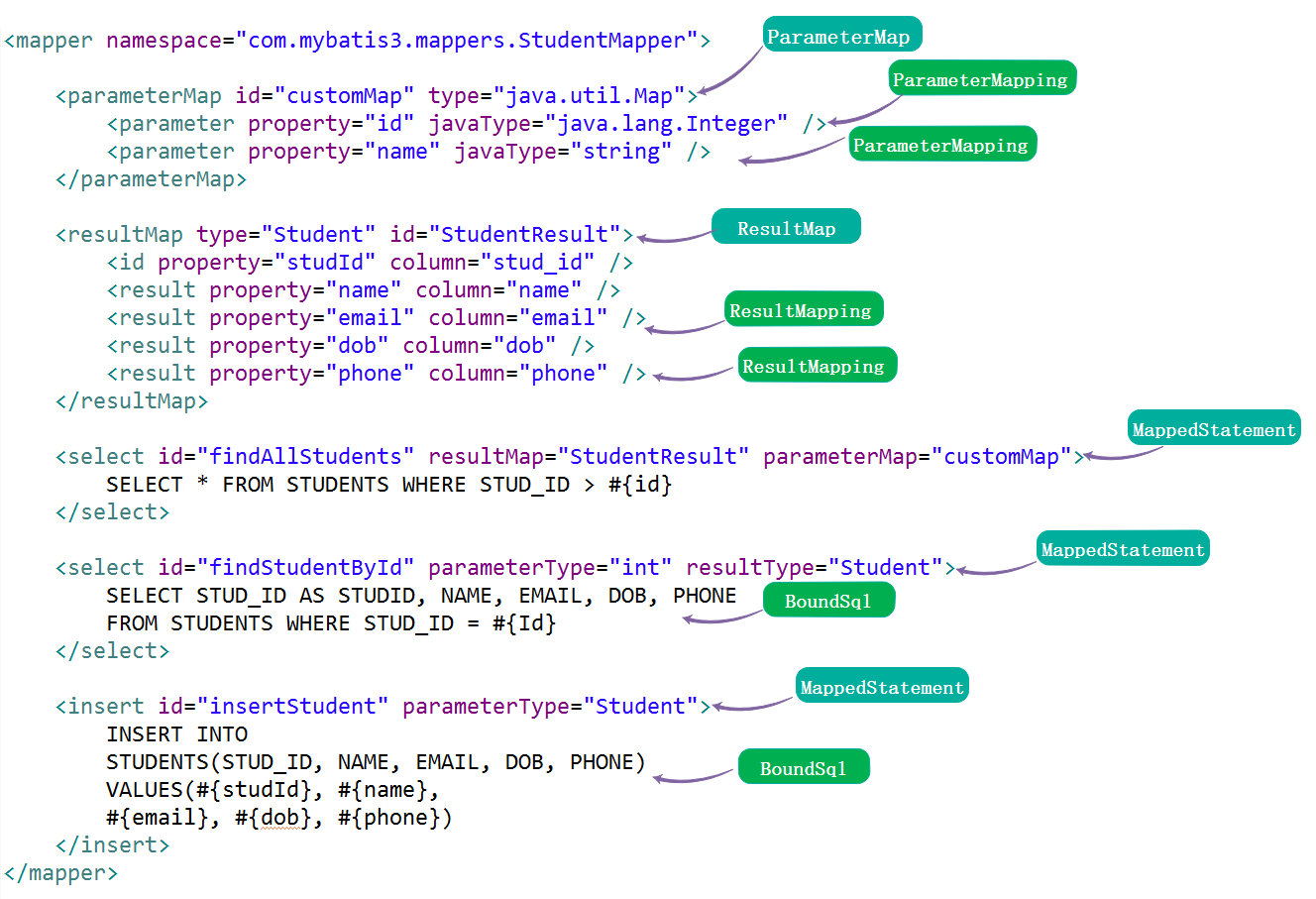ORM - MyBatis初始化基本过程详解
ORM - MyBatis初始化基本过程详解
一、组装All-In-One对象Configuration过程
Mybatis初始化流程,其实就是组装重量级All-In-One对象Configuration的过程,主要分为系统环境参数初始化和Mapper映射初始化,其中Mapper映射初始化尤为重要。
系统环境参数初始化
inputStream = Resources.getResourceAsStream("mybatis-config.xml");
sqlSessionFactory = new SqlSessionFactoryBuilder().build(inputStream);
Mapper映射初始化
public SqlSessionFactory build(InputStream inputStream, String environment, Properties properties) {
XMLConfigBuilder parser = new XMLConfigBuilder(inputStream, environment, properties);
return new DefaultSqlSessionFactory(parser.parse());
}
parser.parse()方法,已经返回了组装完毕的Configuration对象。
二、XMLConfigBuilder.parse()方法
流程进入XMLConfigBuilder.parse()方法。
public Configuration parse() {
parseConfiguration(parser.evalNode("/configuration"));
return configuration;
}
private void parseConfiguration(XNode root) {
try {
Properties settings = settingsAsPropertiess(root.evalNode("settings"));
propertiesElement(root.evalNode("properties"));
loadCustomVfs(settings);
typeAliasesElement(root.evalNode("typeAliases"));
pluginElement(root.evalNode("plugins"));
objectFactoryElement(root.evalNode("objectFactory"));
objectWrapperFactoryElement(root.evalNode("objectWrapperFactory"));
reflectionFactoryElement(root.evalNode("reflectionFactory"));
settingsElement(settings);
environmentsElement(root.evalNode("environments"));
databaseIdProviderElement(root.evalNode("databaseIdProvider"));
typeHandlerElement(root.evalNode("typeHandlers"));
// 重点关注
mapperElement(root.evalNode("mappers"));
} catch (Exception e) {
throw new BuilderException("Error parsing SQL Mapper Configuration. Cause: " + e, e);
}
}
以上代码,对mybatis-config.xml配置文件内的元素,使用XPath进行逐一读取。
<?xml version="1.0" encoding="UTF-8"?>
<!DOCTYPE configuration PUBLIC "-//mybatis.org//DTD Config 3.0//EN" "http://mybatis.org/dtd/mybatis-3-config.dtd">
<configuration>
<properties resource="jdbc.properties">
<property name="username" value="root" />
<property name="password" value="123" />
</properties>
<settings>
<setting name="localCacheScope" value="STATEMENT"/>
<setting name="cacheEnabled" value="false" />
<setting name="lazyLoadingEnabled" value="true" />
<setting name="multipleResultSetsEnabled" value="true" />
<setting name="useColumnLabel" value="true" />
<setting name="useGeneratedKeys" value="false" />
<setting name="defaultExecutorType" value="REUSE" />
<setting name="defaultStatementTimeout" value="25000" />
</settings>
<typeAliases>
<typeAlias alias="Student" type="com.mybatis3.domain.Student" />
<typeAlias alias="Teacher" type="com.mybatis3.domain.Teacher" />
</typeAliases>
<typeHandlers>
<typeHandler handler="com.mybatis3.typehandlers.PhoneTypeHandler" />
</typeHandlers>
<environments default="development">
<environment id="development">
<transactionManager type="JDBC" />
<dataSource type="POOLED">
<property name="driver" value="${driver}" />
<property name="url" value="${url}" />
<property name="username" value="${username}" />
<property name="password" value="${password}" />
</dataSource>
</environment>
</environments>
<mappers>
<mapper resource="com/mybatis3/mappers/StudentMapper.xml" />
<mapper resource="com/mybatis3/mappers/TeacherMapper.xml" />
</mappers>
</configuration>
三、Configuration属性映射表
Xml文件元素和Configuration属性映射表:
<properties>元素:Properties variables。<settings>元素:Integer defaultStatementTimeout、Integer defaultFetchSize、ExecutorType defaultExecutorType……<typeAliases>元素:TypeAliasRegistry typeAliasRegistry。<typeHandlers>元素:TypeHandlerRegistry typeHandlerRegistry。<environments>元素:Environment environment。配置多个<environment>元素时,Mybatis只会读取默认的那一个。<mappers>元素:MapperRegistry mapperRegistry。
Mapper映射初始化是我们关注的重点,即mapperElement(root.evalNode("mappers"))方法。
org.apache.ibatis.builder.xml.XMLMapperBuilder.parse()方法源码。
private void configurationElement(XNode context) {
try {
String namespace = context.getStringAttribute("namespace");
if (namespace == null || namespace.equals("")) {
throw new BuilderException("Mapper's namespace cannot be empty");
}
builderAssistant.setCurrentNamespace(namespace);
cacheRefElement(context.evalNode("cache-ref"));
cacheElement(context.evalNode("cache"));
parameterMapElement(context.evalNodes("/mapper/parameterMap"));
resultMapElements(context.evalNodes("/mapper/resultMap"));
sqlElement(context.evalNodes("/mapper/sql"));
buildStatementFromContext(context.evalNodes("select|insert|update|delete"));
} catch (Exception e) {
throw new BuilderException("Error parsing Mapper XML. Cause: " + e, e);
}
}
四、MyBatis 内部数据结构
逐一读取Mapper.xml文件内的各个元素。为了更为直观的了解xml元素至Mybatis的内部数据结构,我做了一个对照图。

这些Xml配置元素,Mybatis将它们分别封装成了ParameterMap、ParameterMapping、ResultMap、ResultMapping、MappedStatement、BoundSql等内部数据结构对象。
这些数据库结构对象,均放置于Configuration内部保存起来。
protected final Map<String, MappedStatement> mappedStatements = new StrictMap<MappedStatement>("Mapped Statements collection");
protected final Map<String, ResultMap> resultMaps = new StrictMap<ResultMap>("Result Maps collection");
protected final Map<String, ParameterMap> parameterMaps = new StrictMap<ParameterMap>("Parameter Maps collection");
Mybatis初始化流程,经过系统环境参数初始化和Mapper映射初始化,简单的两个步骤就完成了,过程并不复杂。
五、MyBatis 配置参数作用
Properties variables`的作用
通常,我们会单独配置jdbc.properties文件,保存于variables变量中,而Xml文件内可以使用${driver}占位符,读取时可动态替换占位符的值。
扫描package参数
<typeAliases>
<typeAlias alias="Student" type="com.mybatis3.domain.Student" />
<typeAlias alias="Teacher" type="com.mybatis3.domain.Teacher" />
<package name="com.mybatis3.domain" />
</typeAliases>
前两个typeAlias,很容易理解,那么元素如何处理呢?
public void registerAliases(String packageName, Class<?> superType){
ResolverUtil<Class<?>> resolverUtil = new ResolverUtil<Class<?>>();
resolverUtil.find(new ResolverUtil.IsA(superType), packageName);
Set<Class<? extends Class<?>>> typeSet = resolverUtil.getClasses();
for(Class<?> type : typeSet){
// 排除内部类、接口
if (!type.isAnonymousClass() && !type.isInterface() && !type.isMemberClass()) {
registerAlias(type);
}
}
}
namespace如何映射Mapper接口
org.apache.ibatis.builder.xml.XMLMapperBuilder.bindMapperForNamespace()。
直接使用Class.forName(),成功找到就注册,找不到就什么也不做。
Mybatis中的namespace有两个功能。
和其名字含义一样,作为名称空间使用。namespace + id,就能找到对应的Sql。
作为Mapper接口的全限名使用,通过namespace,就能找到对应的Mapper接口(也有称Dao接口的)。Mybatis推荐的最佳实践,但并不强制使用。
Mapper接口注册至Configuration的MapperRegistry mapperRegistry内。
private final Map<Class<?>, MapperProxyFactory<?>> knownMappers = new HashMap<Class<?>, MapperProxyFactory<?>>()
Mapper接口将通过MapperProxyFactory创建动态代理对象。
一个MappedStatement被缓存了两个引用的原理及原因
configuration.addMappedStatement(statement);调用上面一句话,往Map里放置一个MappedStatement对象,结果Map中变成两个元素。
com.mybatis3.mappers.StudentMapper.findAllStudents=org.apache.ibatis.mapping.MappedStatement@add0edd
findAllStudents=org.apache.ibatis.mapping.MappedStatement@add0edd
我们的问题是,为什么会变成两个元素?同一个对象,为什么要存有两个键的引用?
其实,在Mybatis中,这些Map,都是StrictMap类型,Mybatis在StrictMap内做了手脚。
protected static class StrictMap<V> extends HashMap<String, V> {
public V put(String key, V value) {
if (containsKey(key)) {
throw new IllegalArgumentException(name + " already contains value for " + key);
}
if (key.contains(".")) {
final String shortKey = getShortName(key);
// 不存在shortKey键值,放进去
if (super.get(shortKey) == null) {
super.put(shortKey, value);
} else {
// 存在shortKey键值,填充占位对象Ambiguity
super.put(shortKey, (V) new Ambiguity(shortKey));
}
}
return super.put(key, value);
}
}
Mybatis重写了put方法,将id和namespace+id的键,都put了进去,指向同一个MappedStatement对象。如果shortKey键值存在,就填充为占位符对象Ambiguity,属于覆盖操作。
这样做的好处是,方便我们编程。
Student std = sqlSession.selectOne("findStudentById", 1);
Student std = sqlSession.selectOne("com.mybatis3.mappers.StudentMapper.findStudentById", 1);
上面两句代码,是等价的,Mybatis不强制我们一定要加namespace名称空间,所以,这是存放两个键的良苦用心。
问题:不同namespace空间下的id,能否相同呢?(网上的说法是,不同名称空间下的id可以相同)
明白上述put原理后,就不难得出结论,namespace名称空间不同,而id相同时,使用namespace+id获取Sql,完全可以正确执行。如果只用id获取,那么,将导致错误。
org.apache.ibatis.session.Configuration.StrictMap.get()方法源码。
public V get(Object key) {
V value = super.get(key);
if (value == null) {
throw new IllegalArgumentException(name + " does not contain value for " + key);
}
if (value instanceof Ambiguity) {
throw new IllegalArgumentException(((Ambiguity) value).getSubject() + " is ambiguous in " + name
+ " (try using the full name including the namespace, or rename one of the entries)");
}
return value;
}
get时,如果得到的是一个占位对象Ambiguity,就抛出异常,要求使用full name进行调用。full name就是namespace+id。Ambiguity意为模糊不清。
解决办法:
- 保证shortKey(即id)不重复。(好像有点难度,不推荐)
- 使用绑定Mapper接口调用方法,因为它总是转换为full name调用。(Mybatis最佳实践,推荐)
- 直接使用字符串full name调用。(退而求其次的方式,不推荐)
初始化过程中的mapped和incomplete对象
翻译为搞定的和还没搞定的。这恐怕是Mybatis框架中比较奇葩的设计了,给人很多迷惑,我们来看看它具体是什么意思。
<resultMap type="Student" id="StudentResult" extends="Parent">
<id property="studId" column="stud_id" />
<result property="name" column="name" />
<result property="email" column="email" />
<result property="dob" column="dob" />
</resultMap>
<resultMap type="Student" id="Parent">
<result property="phone" column="phone" />
</resultMap>
Mapper.xml中的很多元素,是可以指定父元素的,像上面extends="Parent"。然而,Mybatis解析元素时,是按顺序解析的,于是先解析的id="StudentResult"的元素,然而该元素继承自id="Parent"的元素,但是,Parent被配置在下面了,还没有解析到,内存中尚不存在,怎么办呢?Mybatis就把id="StudentResult"的元素标记为incomplete的,然后继续解析后续元素。等程序把id="Parent"的元素也解析完后,再回过头来解析id="StudentResult"的元素,就可以正确继承父元素的内容。
先标记 后解析能解析到的 回头再解析一边之前标记过的 这个顺序
简言之就是,你的父元素可以配置在你的后边,不限制非得配置在前面。无论你配置在哪儿,Mybatis都能“智能”的获取到,并正确继承。
这便是在Configuration对象内,有的叫mapped,有的叫incomplete的原因。
protected final Collection<XMLStatementBuilder> incompleteStatements = new LinkedList<XMLStatementBuilder>();
protected final Collection<CacheRefResolver> incompleteCacheRefs = new LinkedList<CacheRefResolver>();
protected final Collection<ResultMapResolver> incompleteResultMaps = new LinkedList<ResultMapResolver>();
protected final Collection<MethodResolver> incompleteMethods = new LinkedList<MethodResolver>();
org.apache.ibatis.builder.xml.XMLMapperBuilder.parse()方法内,触发了incomplete的再度解析。
public void parse() {
if (!configuration.isResourceLoaded(resource)) {
configurationElement(parser.evalNode("/mapper"));
configuration.addLoadedResource(resource);
bindMapperForNamespace();
}
// 执行incomplete的地方
parsePendingResultMaps();
parsePendingChacheRefs();
parsePendingStatements();
}
Pending含义为待定的,悬而未决的意思。
引用资料
- https://www.cnblogs.com/hochan100/p/15127477.html
- https://www.cnblogs.com/hochan100/p/15129646.html
